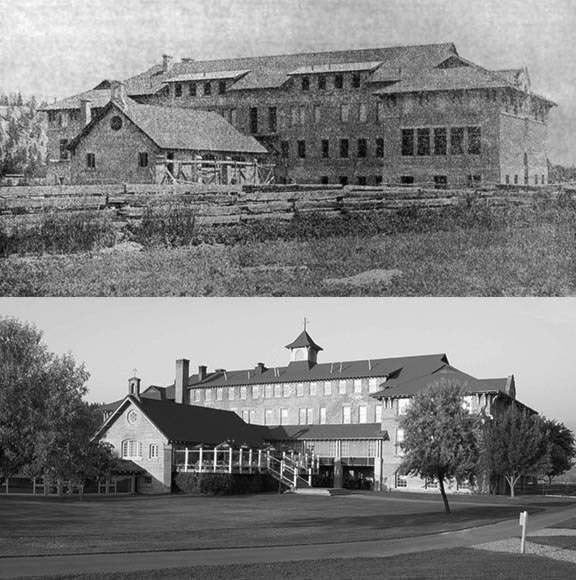Jim Cameron
"A nation is not conquered until the hearts of its women are on the ground. Then, it is done, no matter how brave its warriors nor how strong its weapons."
Cheyenne proverb.
On April 20, 1910, the Department of Indian Affairs invited tenders for the immediate construction of an industrial school at the St. Eugene Mission near Cranbrook. It would be one of the first in the province and would replace the existing school established two decades earlier. In early June, Fernie contractor J. J. Woods was awarded the task. Authorization arrived from Ottawa the following month and work began on July 26, 1911.
On the afternoon of Nov. 1 1911, Oblate Missionary Father Beck laid the cornerstone of the building in front of a large gathering comprised chiefly of members of the Kootenay (Ktunaxa) tribe. R.T. Galbraith, local Indian Agent of eighteen years, gave a short address followed by Father Beck. The keynote of Father Beck's address dealt with the fact that "the true Christian made the best man and therefore the Canadian government took care to see that its Indian protégées should have every opportunity of becoming good Christians. In closing he impressed upon the Indian parents to realize their responsibility and see to it that their children enjoyed the privilege of the training given at the residential school."
The cornerstone itself contained a written history of the establishment of the school, two Cranbrook and one Nelson newspapers, coins of the reign of Kings Edward and George and (perhaps somewhat oddly) medals fashioned from copper taken from Lord Nelson's flagship "Victory." What was not included was the fact that many residential schools soon to be constructed throughout Canada, would function in the most Draconian fashion imaginable, with children of all ages torn away from their homes for the duration of their "education" and held as little more than prisoners while being subjected to abuses and deprivations of the worst sort. That lay in the future, however. First came the building.
The construction of the St. Eugene school carried on through the spring of 1912. Various delays, including an extended wait for the granite steps of the main entrance and the boilers necessary for the heating system slowed things and thus it was not until Dec. 1912, that the school was more or less complete. It stood as one of the largest buildings in western Canada, a bleak, concrete behemoth hulking over the landscape, a constant reminder to parents that their children were now firmly in the hands of the Federal government and its appointed taskmasters.
Fifty-five feet high and composed of nearly 27,000 exterior concrete blocks with 350,000 locally manufactured bricks in the interior, it was proclaimed as one of the most up-to-date building for the purpose in the west.
Upon entering the main entrance one passed through a vestibule into a corridor to the left of which was the Sister Superior’s reception room and staff living room. To the right stood the Indian Agent’s office and a parlour, bedroom and bath for visiting officials. To the fore stood the staff and visitor’s dining rooms, the staff infirmary and convalescent wards and a bathing area. A corridor connected to the Mission-style chapel at the rear of the building. At the southern end stood the girls classrooms and to the north, that of the boys.
The upper floor held the dormitories, with the Sister’s in the center and the children’s at each end. Connected to both the Sister’s and the girl’s dormitory was a loggia, or outdoor sleeping balcony, connected to an infirmary with the same for the boys on the other end. The exposed sleeping areas were intended, so it was reported, “for the treatment of the children that may from time to time develop or exhibit signs of tubercular troubles or for the children who are fresh into the school from the reserve, where they live very largely in the open air and tents.” (It should be noted that a 2011 Canadian government inquiry into deaths of students at Indian residential schools failed to ascertain actual numbers although numerous other reports and research papers have made educated guesses. Overcrowding, poor sanitation and a lack of medical care led to a high rate of tuberculosis and whooping cough causing death rates in some schools estimated as high as 50 - 60 per cent. Compulsory government sterilization of students was also practiced in some provinces.)
Each end of the basement contained recreation, shower and toilet rooms for the children while the central portion was taken up by the large main dining room, kitchen, larder and cold storage rooms. The foremost section contained the heating plant adjoining a generator room (containing a 15 horsepower gasoline engine which produced all light at the Mission including the two hundred bulbs in the school) and a dispensary. The bakery, creamery and living quarters for the farm instructors and janitor sat beneath the chapel. Under the basement floor was the sewage drainage system leading to a large septic tank 350 ft. from the building. The attic was reserved as a recreational space during inclement weather and storage.
As to the schooling received, a 1910 school report issued by Father Beck indicates that education consisted largely of the tending of gardens, orchards and farm animals. Boys were given some manual training while girls studied the “domestic arts.” The school closed in 1970. It is now part of the St. Eugene Mission Resort.
Next week: The Black Robes of the White Man’s Burden.
